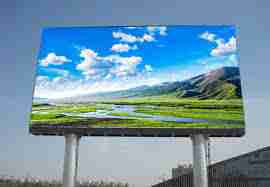The outdoor LED display market is undergoing a wave of rapid evolution propelled by cutting-edge technological breakthroughs. The latest innovations in display resolution, interactivity, connectivity, and sustainability are reshaping opportunities in urban advertising, public communication, entertainment venues, smart cities, and beyond. As the sector continues to mature, several key developments are redefining its future trajectory.

1. Ultra-High-Resolution and Fine-Pitch SMD Displays
2025 has seen a leap in picture quality for outdoor LED displays, thanks to refined Surface-Mounted Device (SMD) technology. Manufacturers are delivering outdoor-capable 4K and 8K screens with ultra-fine pixel pitches, ensuring crisp imagery even from close distances—ideal for dense urban environments and transportation hubs. These advances enable brands and advertisers to showcase high-detail content that captures attention and elevates visual storytelling.
2. Full Interactivity and Smart Connectivity
Interactivity has emerged as a standout feature in outdoor digital signage. The integration of touch screens, gesture control, QR/NFC modules, and smartphone-triggered campaigns is transforming displays from passive ads into engagement tools. Interactive transparency, mesh displays on building facades, and AR overlays are increasingly common in retail districts and public spaces, offering personalized, dynamic experiences that blend the physical and digital worlds.
3. AI-Driven Content Personalization
Artificial Intelligence is revolutionizing content scheduling for outdoor displays. Smart systems now analyze ambient conditions—like traffic flow, weather, and demographics—to deliver contextually relevant messaging in real time. AI-powered content management tools optimize message scheduling and engagement, while predictive analytics can adjust brightness and content dynamically, minimizing energy usage and maximizing returns.
4. Weatherproof, Ultra-Durable Design
With outdoor environments being unpredictable, durability has become a priority. New LED enclosures now offer enhanced sealing, anti-glare nano-coatings, tempered glass, and fanless vapor-chamber cooling systems capable of operating across extreme temperatures. These design enhancements ensure reliable performance in harsh conditions—high heat, coastal humidity, urban dust, snowfall, and even vandal-prone settings.
5. Transparency, Flexibility, and Curved Displays
Interactive transparent and mesh LED panels are revolutionizing architectural integration, notably in building facades and glass storefronts. These see-through displays offer visibility while showcasing digital content—ideal for immersive brand activations. Meanwhile, constrained spaces spur demand for curved LED screens that add creative flair and help blend technology with urban aesthetics.
6. Edge‑Ready 5G, Mini, and Micro‑LED Displays
The introduction of outdoor mini-LED and micro-LED displays—boasting low power, high brightness, accurate color, and modular form factors—is on the rise. These cutting-edge LEDs support integration with 5G and edge computing, enabling real-time data feeds such as weather, traffic updates, financial tickers, and transport messaging.
7. Sustainable, Low‑Power and Solar‑Ready Designs
Environmental pressures are fueling the demand for energy-efficient outdoor LEDs. Today’s displays consume significantly less power—up to 50% reductions—through automated brightness control, passive cooling, and solar compatibility, contributing to sustainability goals and lower operational costs. Green-certified displays are increasingly favored in smart-city contracts and among eco-conscious businesses.
8. Remote Management and Cloud Control
The era of cloud-based, centralized content management has arrived. Remote platforms allow operators to manage multiple displays, update campaigns, monitor system health, and apply AI-driven scheduling from a single dashboard. This dramatically streamlines operations, supports rapid responsiveness, reduces service costs, and ensures consistent brand messaging.
9. Emerging Interactive Sports and Arena Applications
Beyond signage, LED adoption is entering new segments such as sports and entertainment. Interactive LED floors, video walls, and real-time fan engagement displays are transforming the experience at sports venues and entertainment arenas. Though still niche and evolving, this technology signals the future direction of LED integration in live events and immersive spaces.
Implications and Market Outlook
These recent developments position the outdoor LED display market at the intersection of technology, infrastructure, and user experience. The combination of ultra-HD visuals, AI integration, interactivity, modularity, and sustainability is expanding LED applications in urban planning, retail, transportation, tourism, and entertainment.
As LEDs evolve to be more intelligent, responsive, visually stunning, and environmentally friendly, demand is expected to surge. Public-private partnerships in smart-city initiatives, experiential advertising, and infrastructure modernization will accelerate adoption. Companies offering turnkey, interactive, and AI-driven solutions are likely to lead the next wave of growth.
Challenges and the Road Ahead
Despite remarkable innovation, challenges remain. High-resolution micro-LED systems remain costly; interactive installations require robust content ecosystems and skilled technical support; regulatory concerns such as light pollution and privacy must be addressed. Integration with existing infrastructure and diverse global standards may slow deployment in certain regions.
However, as technology costs decrease, and as sustainability, connectivity, and AI-driven platforms mature, the outdoor LED display market is poised for significant growth.
Conclusion
2025 is shaping up to be a transformative year for outdoor LED displays. From cloud-managed systems and interactive facades to ultra-durable modular screens and immersive sports applications, recent developments are redefining how cities communicate, how brands engage, and how public spaces evolve. As innovation continues, the outdoor LED display market will play a crucial role in enhancing global urban experiences.



